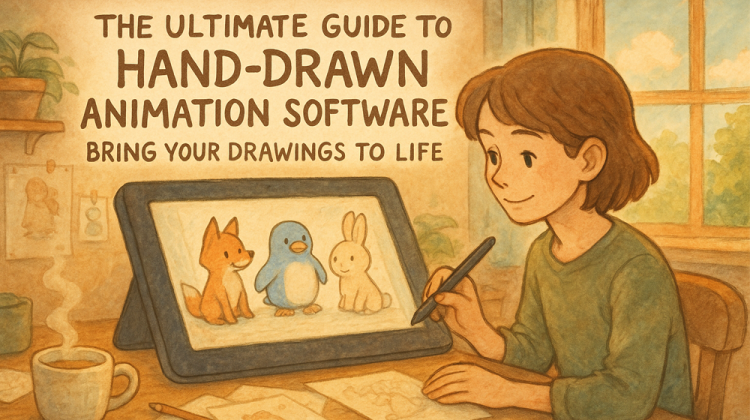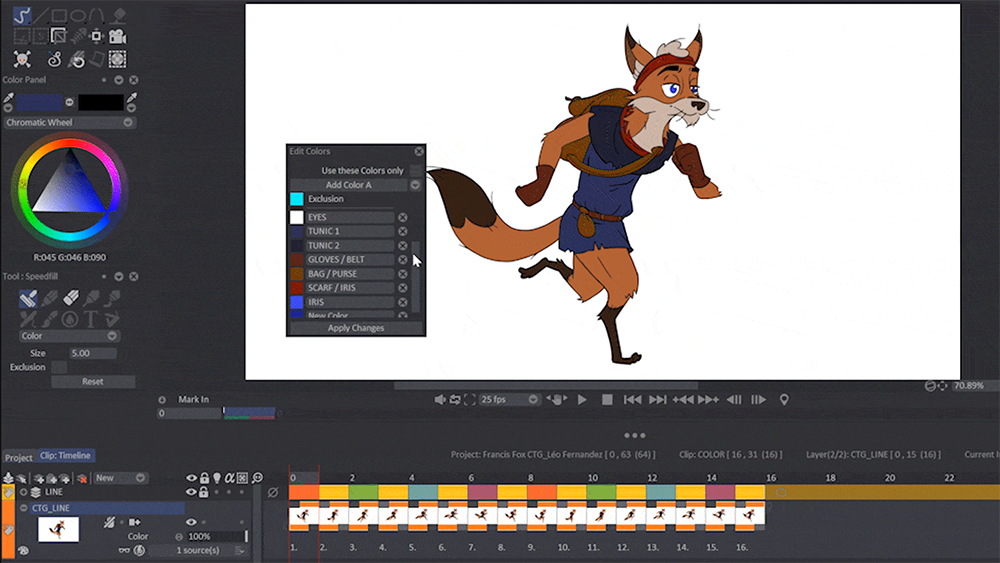
HAND-DRAWN Animation continues to captivate audiences with its unique charm and artistic expression. Modern digital software tools have revolutionized this traditional art form, making it more accessible and efficient without sacrificing the distinctive qualities that make hand-drawn animation special.
This guide explores the best software options available today, their key features, and how to choose the right one for your projects.
1. Popular Hand-Drawn Animation Software Tools at a Glance
This comparison highlights the key features, pricing models, and target users for the most popular animation software available this year.

The world of hand-drawn animation software offers a diverse range of tools to suit every skill level, budget, and creative goal. From industry standards used in major studios to free open-source alternatives, today’s digital artists have more options than ever before.
2. Software Deep Dive

For animators serious about choosing the right tools, a surface-level comparison often isn’t enough. Each animation program offers unique workflows, specialized features, and distinct advantages that only become apparent through deeper exploration.
2.1. Adobe Animate

Adobe Animate stands out for its versatility and integration with the Creative Cloud ecosystem. Originally Flash, this vector-based animation tool excels at:
- Creating scalable animations that maintain quality at any resolution
- Producing interactive content and web animations
- Supporting both frame-by-frame animation and tweening
- Offering multiple export formats (HTML5, WebGL, SVG)
While its $22.99/month subscription cost may deter some, Animate remains an industry standard for web animation and offers a familiar interface for Adobe users.
2.2. Clip Studio Paint
Clip Studio Paint stands out as a powerful tool that bridges the gap between illustration and animation. Originally developed for digital artists and manga creators, this software excels at:
- Providing exceptional brush quality that mimics traditional art tools
- Supporting frame-by-frame animation with comprehensive onion skinning
- Offering cross-platform functionality across desktop and mobile devices
- Including specialized tools for comics and manga creation
Available in two editions—Pro ($59.99 one-time or $4.49/month) and EX ($219 one-time or $8.99/month)—the EX version removes the 24-frame animation limit found in Pro.
You can also browse our collection of Clip Studio Paint deals by clicking here. Particularly popular in the anime industry, Clip Studio Paint is ideal for artists who prioritize drawing quality in their animation workflow.
2.3. Toon Boom Harmony

The powerhouse of professional 2D animation, Toon Boom Harmony is used by major studios worldwide. Its standout features include:
- Advanced rigging system for sophisticated character animation
- Support for both vector and bitmap workflows
- Powerful compositing tools with node-based system
- 3D integration capabilities
- Comprehensive drawing tools with customizable brushes
Available in three tiers (Essentials, Advanced, Premium), Harmony has a steeper learning curve but offers unmatched capabilities for serious animation projects.
2.4. TVPaint Animation

TVPaint takes a different approach with its bitmap-based technology, focusing on recreating the traditional animation experience digitally:
- Natural media brushes that mimic traditional drawing tools
- Dual papers system for unique texture effects
- Strong light table and onion skinning features
- Frame-by-frame animation focus
- One-time purchase model rather than subscription
Popular in European animation studios and for projects requiring a painterly style, TVPaint excels at traditional animation techniques.
2.5. Moho (formerly Anime Studio)

Moho shines with its powerful yet user-friendly rigging system:
- Smart bones and inverse kinematics for efficient character animation
- Vector-based drawing tools optimized for animation
- Physics engine for realistic motion
- Support for PSD and SVG files
- Available in Pro and Debut versions
Perfect for animators who want to create character animations efficiently without drawing every frame. Moho (formerly Anime Studio) is available in two versions with the following pricing structure:
- Moho Debut: Approximately $59.99 for a one-time purchase (entry-level version)
- Moho Pro: Approximately $399.99 for a one-time purchase (professional version)
If you’re looking for a deal, check out our collection of Moho Discount Codes.
2.6. Free and Open-Source Options
Several high-quality free options have emerged in recent years:

Krita – Originally a digital painting program with added animation features:
- Exceptional brush engine
- Strong layer management
- Drawing assistants and stabilizers
- Active development community

OpenToonz – Based on software used by Studio Ghibli:
- Professional-level toolset
- GTS scanning tool for traditional drawings
- Support for both raster and vector
- Xsheet and timeline interfaces

Pencil2D – Focused on simplicity:
- Minimal interface
- Easy switching between vector and raster
- Perfect for beginners and quick sketches

Blender – Though primarily 3D software, its Grease Pencil feature offers powerful 2D capabilities:
- Draw directly in 3D space
- Combine 2D and 3D elements
- Extensive animation tools
- Growing community support
3. How to Choose the Right Software

When selecting animation software, consider these factors:
- Skill Level – Beginners might prefer Pencil2D or Krita for their simplicity, while professionals may need Harmony or TVPaint’s advanced features
- Project Requirements – Consider what you’re creating:
- Web content? Adobe Animate excels
- Traditional animation? TVPaint offers the best feel
- Character animation with minimal drawing? Moho’s rigging system shines
- Hybrid 2D/3D work? Blender is unmatched
- Budget Constraints – Options range from free (Krita, OpenToonz, Pencil2D, Blender) to one-time purchases (TVPaint, Moho) to subscriptions (Adobe, Toon Boom)
- Hardware Limitations – Some software requires more powerful computers than others
- Workflow Preferences – Consider whether you prefer:
- Frame-by-frame drawing
- Rigging and puppetry
- Vector or bitmap-based approaches
4. Notable Projects Created with Different Software
The capabilities of these programs are demonstrated by their use in professional productions:
- Toon Boom Harmony: Disney’s “The Princess and the Frog” (shown above), numerous Cartoon Network shows
- TVPaint: Cartoon Saloon’s “Wolfwalkers,” “Song of the Sea,” Studio Ghibli’s “The Red Turtle”
- Moho: “Puffin Rock” animated series
- OpenToonz: Various Studio Ghibli productions, “Futurama,” “Steven Universe”
- Adobe Animate: “Star Wars Galaxy of Adventures” shorts
5. Future Trends in Hand-Drawn Animation Software

The field continues to evolve with several exciting developments:
- AI Integration – Machine learning assistance for tasks like in-betweening and lip-syncing
- Improved User Interfaces – Making professional tools more accessible
- Hybrid Techniques – Better integration between 2D and 3D workflows
- Mobile Animation – More powerful tools for tablets and smartphones
- Community-Driven Development – Open-source options gaining features through active communities
6. Conclusion
The golden age of hand-drawn animation software is here, with options available for every skill level, budget, and artistic vision. Whether you’re a beginner creating your first animated loop or a professional studio producing feature films, there’s never been a better time to bring your drawings to life through animation.
The best approach is often to try several options through free trials or open-source alternatives before committing to a particular software ecosystem. Your perfect animation tool awaits – one that balances your technical needs with your artistic sensibilities.





